Study on the Spatial and Temporal Distribution of the High–Quality Development of Urbanization and Water Resource Coupling in the Yellow River Basin
Abstract
1. Introduction
2. Literature Review
2.1. Urbanization and High–Quality Development of Urbanization
2.2. The Relationship between Urbanization and Water Resources
2.3. Summary
3. Data Sources and Research Methods
3.1. Study Area and Data Sources
3.2. Research Process
3.3. The Concept of “High–Quality Urbanization Development—Water Resources Coupling” and the Construction of Index System
3.3.1. The Concept of “High–Quality Urbanization Development—Water Resources Coupling”
3.3.2. The Construction of the Index System
3.4. Research Method
3.4.1. Determination of the Weights of Indicators
The Entropy Weight Method
- (1)
- Construct a judgment matrix composed of m evaluation objects and n evaluation indicators, and normalize it to obtain a standardized matrix :in which, for the indicators that belong to the “the larger the better (positive)” type:for the indicators that belong to the “the smaller the better (negative)” type:and for the moderate indicators:
- (2)
- Define the entropy of the j–th indicator:in which
- (3)
- Calculate the weight of the j–th indicator:
Analytic Hierarchy Process (AHP)
Combination Weight
3.4.2. Coupling Coordination Degree Model
Comprehensive Development Index
Coupling Coordination Degree (CCD)
3.4.3. Cluster Analysis Model with Ward’s Method
3.4.4. Obstacle Degree Model
4. Results and Discussion
4.1. Comprehensive Development Index
4.1.1. Comprehensive Development Index in the Yellow River Basin
4.1.2. Comprehensive Development Index of Nine Provinces
4.1.3. Comprehensive Development Index of Subsystems
4.2. Coupling Coordination Status
4.2.1. Temporal Variation in the Coupling Coordination Degree
4.2.2. Spatial Variation of Coupling Coordination Degrees
4.3. Diagnosis of Obstacle Factors
4.4. Comparative Analysis
5. Conclusions and Suggestions
Author Contributions
Funding
Institutional Review Board Statement
Informed Consent Statement
Data Availability Statement
Conflicts of Interest
References
- An, X.W.; Li, Y.; Wang, L.Y.; Dong, G.H.; Dai, B.X.; Liang, M.X. The Spatial and Temporal Distribution of High–Quality Urbanization Development in Yellow River Basin Provinces. Sustainability 2022, 14, 10355. [Google Scholar] [CrossRef]
- Bloom, D.E.; Canning, D.; Fink, G. Urbanization and the wealth of nations. Science 2008, 319, 772–775. [Google Scholar] [CrossRef]
- Michaels, G.; Rauch, F.; Redding, S.J. Urbanization and Structural Transformation. Q. J. Econ. 2012, 127, 535–586. [Google Scholar] [CrossRef]
- Kolko, J. Urbanization Agglomeration and Coagglomeration of Service Industries; University of Chicago Press: Chicago, IL, USA, 2010; Volume 89. [Google Scholar]
- Turok, I.; McGranahan, G. Urbanization and economic growth: The arguments and evidence for Africa and Asia. Environ. Urban. 2013, 25, 465–482. [Google Scholar] [CrossRef]
- Mcgranahan, G.; Songsore, J.; Kjellen, M. Sustainability Poverty and Urbanenvironmental transitions. Sustain. Environ. Urban. 1996, 132–140. [Google Scholar]
- Gu, C.L.; Hu, L.Q.; Cook, I.G. China’s urbanization in 1949–2015: Processes and driving forces. Chin. Geogr. Sci. 2017, 27, 847–859. [Google Scholar] [CrossRef]
- Chen, M.X.; Liu, W.D.; Tao, X.L. Evolution and assessment on China’s urbanization 1960–2010: Under–urbanization or over–urbanization? Habitat Int. 2013, 38, 25–33. [Google Scholar] [CrossRef]
- Chu, N.; Zhang, P.; Wu, X. Spatiotemporal evolution characteristics of urbanization and its coupling coordination degree in Russia—Perspectives from the population, economy, society, and eco–environment. Environ. Sci. Pollut. Res. 2022, 29, 61334–61351. [Google Scholar] [CrossRef]
- Zhou, J.Y.; Zhang, X.L.; Shen, L.Y. Urbanization bubble: Four quadrants measurement model. Cities 2015, 46, 8–15. [Google Scholar] [CrossRef]
- Wang, B.; Gao, X. Temporal and spatial variations of water resources constraint intensity on urbanization in the Shiyang River Basin, China. Environ. Dev. Sustain. 2020, 23, 10038–10055. [Google Scholar] [CrossRef]
- Avazdahandeh, S.; Khalilian, S. The effect of urbanization on agricultural water consumption and production: The extended positive mathematical programming approach. Environ. Geochem. Health 2020, 43, 247–258. [Google Scholar] [CrossRef]
- Mu, L.; Fang, L.; Dou, W.; Wang, C.; Qu, X.; Yu, Y. Urbanization–induced spatio–temporal variation of water resources utilization in northwestern China: A spatial panel model based approach. Ecol. Indic. 2021, 125, 107457. [Google Scholar] [CrossRef]
- Zhang, K.Z.; Shen, J.Q.; He, R.; Fan, B.H.; Han, H. Dynamic Analysis of the Coupling Coordination Relationship between Urbanization and Water Resource Security and Its Obstacle Factor. Int. J. Environ. Res. Public Health 2019, 16, 4765. [Google Scholar] [CrossRef] [PubMed]
- Wang, Y.; Xiao, W.H.; Wang, Y.C.; Zhao, Y.; Wang, J.H.; Hou, B.D.; Song, X.Y.; Zhang, X.L. Impact of China’s Urbanization on Water Use and Energy Consumption: An Econometric Method and Spatiotemporal Analysis. Water 2018, 10, 1323. [Google Scholar] [CrossRef]
- Han, H.; Li, H.M.; Zhang, K.Z. Spatial–Temporal Coupling Analysis of the Coordination between Urbanization and Water Ecosystem in the Yangtze River Economic Belt. Int. J. Environ. Res. Public Health 2019, 16, 3757. [Google Scholar] [CrossRef] [PubMed]
- Zhang, Q.; Peng, J.T.; Singh, V.P.; Li, J.F.; Chen, Y.Q.D. Spatio–temporal variations of precipitation in arid and semiarid regions of China: The Yellow River basin as a case study. Glob. Planet. Chang. 2014, 114, 38–49. [Google Scholar] [CrossRef]
- National Bureau of Statistics of China. China Statistical Yearbook; China Statistics Press: Beijing, China, 2011–2022.
- China Bureau of Statistics. China Urban Statistical Yearbook; China Statistics Press: Beijing, China, 2011–2022.
- Wang, M.; Zhao, X.L.; Gong, Q.X.; Ji, Z.G. Measurement of Regional Green Economy Sustainable Development Ability Based on Entropy Weight–Topsis–Coupling Coordination Degree–A Case Study in Shandong Province, China. Sustainability 2019, 11, 280. [Google Scholar] [CrossRef]
- Xu, H.; Shi, N.; Wu, L.; Zhang, D. High–quality development level and its spatiotemporal changes in the Yellow River Basin. Resour. Sci. 2020, 42, 115–126. [Google Scholar] [CrossRef]
- He, W. Comprehensive Evaluation of Chinas Regional Economic Development Quality Based on RAGA–PPC. J. Zhongnan Univ. Econ. Law 2013, 4, 49–56. [Google Scholar]
- Shi, Y.; Zhu, Q.; Xu, L.; Lu, Z.; Wu, Y.; Wang, X.; Fei, Y.; Deng, J. Independent or Influential? Spatial–Temporal Features of Coordination Level between Urbanization Quality and Urbanization Scale in China and Its Driving Mechanism. Int. J. Enviorn. Res. Public Health 2020, 17, 1587. [Google Scholar] [CrossRef]
- Lan, Q.; Liu, Z.; Peng, Y. The Construction of Evaluation Index System for Quality of New—pattern Urbanization and its Evaluation Method: Based on Study of Spatial Differences among China’s 31 provinces (cities) during the year of 2003 to 2014. South China J. Econ. 2017, 1, 111–126. [Google Scholar]
- Zhang, T.; Li, L. Research on temporal and spatial variations in the degree of coupling coordination of tourism–urbanization–ecological environment: A case study of Heilongjiang, China. Environ. Dev. Sustain. 2021, 23, 8474–8491. [Google Scholar] [CrossRef]
- Fang, G.; Wang, Q.; Tian, L. Green development of Yangtze River Delta in China under Population–Resources–Environment–Development–Satisfaction perspective. Sci. Total Environ. 2020, 727, 138710. [Google Scholar] [CrossRef] [PubMed]
- Ma, R. Study of Evaluating High–quality Economic Development in Chinese Regions. China Soft Sci. 2019, 7, 60–67. [Google Scholar]
- Xu, L.; Yao, S.; Chen, S.; Xu, Y. Evaluation of Eco–city Under the Concept of High–quality Development Evaluation of Eco–city Under the Concept of High–quality Development: A Case Study of the Yangtze River Delta Urban Agglomeration. Sci. Geogr. Sin. 2019, 39, 1228–1237. [Google Scholar]
- Cheng, X.; Long, R.Y.; Chen, H.; Li, Q.W. Coupling coordination degree and spatial dynamic evolution of a regional green competitiveness system—A case study from China. Ecol. Indic. 2019, 104, 489–500. [Google Scholar] [CrossRef]
- Li, W.; Han, J. Quality Development Measurement of the Yellow River Basin in the Context of “Five Development Concepts”. J. Luoyang Norm. Univ. 2020, 39, 1–10. [Google Scholar]
- Yuan, X.; Li, C.; Fang, K. Retrospect and Prospect of Research on Air Pollution in the Context of China’s Ubanization. Econ. Perspect. 2019, 5, 88–103. [Google Scholar]
- Li, M.; Ren, B. Comprehensive Evaluation and Path Choice of China’s High–Quality Development in the New Era. Financeeconomics 2019, 5, 26–40. [Google Scholar]
- Zhang, Z.; Li, Y. Coupling coordination and spatiotemporal dynamic evolution between urbanization and geological hazards–A case study from China. Sci Total Enviorn. 2020, 728, 138825. [Google Scholar] [CrossRef]
- Li, Y.F.; Li, Y.; Zhou, Y.; Shi, Y.L.; Zhu, X.D. Investigation of a coupling model of coordination between urbanization and the environment. J. Environ. Manag. 2012, 98, 127–133. [Google Scholar] [CrossRef]
- Zhang, Z.; Liu, M. Construction and Measurement of High–quality Development Evaluation System of China’s 15 Sub–provincial Cities in the New Era. Inq. Econ. Issues 2019, 6, 20–31+70. [Google Scholar]
- Li, W.; Yi, P.; Zhang, D.; Zhou, Y. Assessment of coordinated development between social economy and ecological environment: Case study of resource–based cities in Northeastern China. Sustain. Cities Soc. 2020, 59, 102208. [Google Scholar] [CrossRef]
- Wang, G.; Xiao, C.L.; Qi, Z.W.; Meng, F.A.; Liang, X.J. Development tendency analysis for the water resource carrying capacity based on system dynamics model and the improved fuzzy comprehensive evaluation method in the Changchun city, China. Ecol. Indic. 2021, 122, 107232. [Google Scholar] [CrossRef]
- Li, S.; Ma, H.; Hou, Y. Dynamic coupling analysis of urbanization and water resources system in Beijing. Yangtze River 2018, 49, 60–64+74. [Google Scholar]
- Wang, T.X.; Xu, S.G. Dynamic successive assessment method of water environment carrying capacity and its application. Ecol. Indic. 2015, 52, 134–146. [Google Scholar] [CrossRef]
- Nie, D. Study on coupling relationship between urbanization level and water resources environment in yingkou city. Heilongjiang Hydraul. Sci. Technol. 2020, 48, 113–117. [Google Scholar]
- Ma, H.; Li, S. Study on the Development and Coordination of Urbanization and Water Resources System in Beijing–Tianjin–Hebei Region. Contemp. Econ. Manag. 2017, 39, 61–67. [Google Scholar]
- Yang, Y. Study on the coordination mechanism between urbanization development and water resources environment in Liaohe River Basin based on coupling model. Water Conserv. Plan. Des. 2020, 3, 49–53+86. [Google Scholar]
- Wang, L.; Huang, X.; Li, H. Evaluation of water resource carrying capacity in nine provinces in the Yellow River Basin based on CW–FSPA. China Rural. Water Hydropower 2021, 9, 67–75. [Google Scholar]
- Wang, C.; Tang, N. Spatio–temporal characteristics and evolution of rural production–living–ecological space function coupling coordination in Chongqing Municipality. Geogr. Res. 2018, 37, 1100–1114. [Google Scholar]
- Qiao, R.; Li, H.M.; Han, H. Spatio–Temporal Coupling Coordination Analysis between Urbanization and Water Resource Carrying Capacity of the Provinces in the Yellow River Basin, China. Water 2021, 13, 376. [Google Scholar] [CrossRef]
- Gong, L.; Meng, X.; Liu, N.; Bi, J. Evaluation of apple quality based on principal component and hierarchical cluster analysis. Trans. Chin. Soc. Agric. Eng. 2014, 30, 276–285. [Google Scholar]
- Zhao, H.; Zhu, L.; Liu, D. Application of Ward System Clustering Method in Multivariate Stratified Sampling Technique. Stat. Decis. 2006, 12, 67–68. [Google Scholar]
- Yang, Z. Regional spatial cluster analysis based on Ward method. China Popul. Resour. Environ. 2010, 20, 382–386. [Google Scholar]
- Xi, J. Speech at the symposium on ecological protection and high–quality development of the Yellow River Basin. Water Resour. Dev. Manag. 2019, 20, 1–4. [Google Scholar]
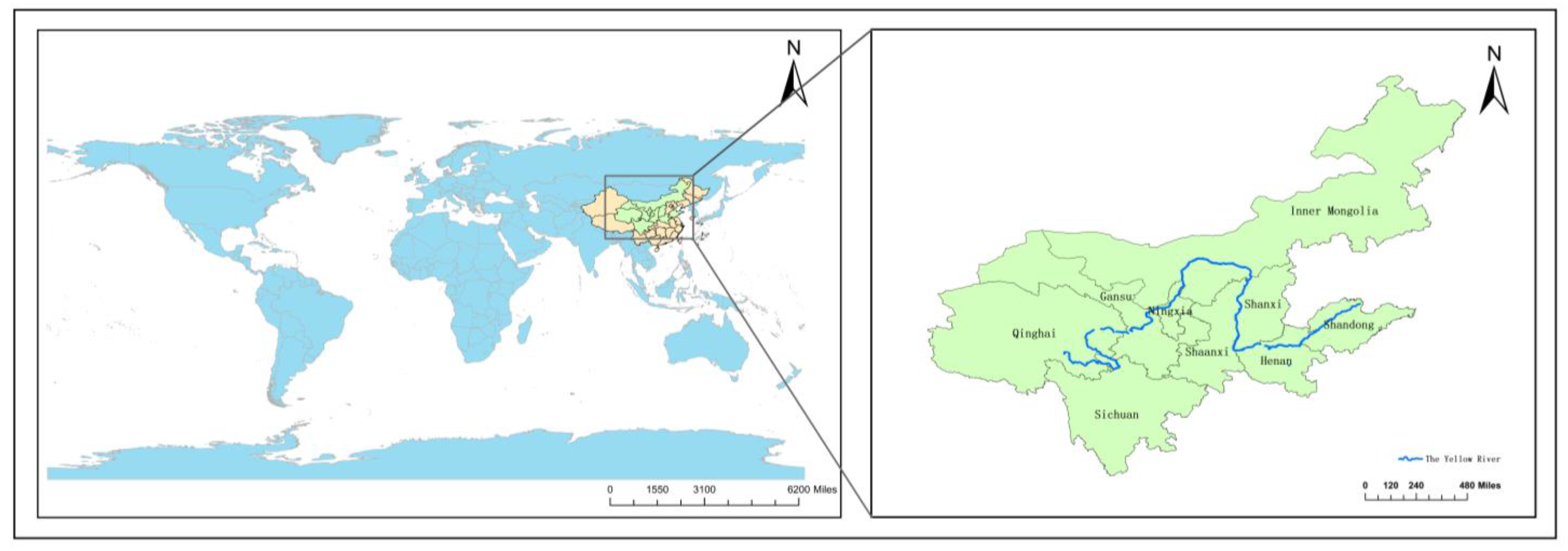
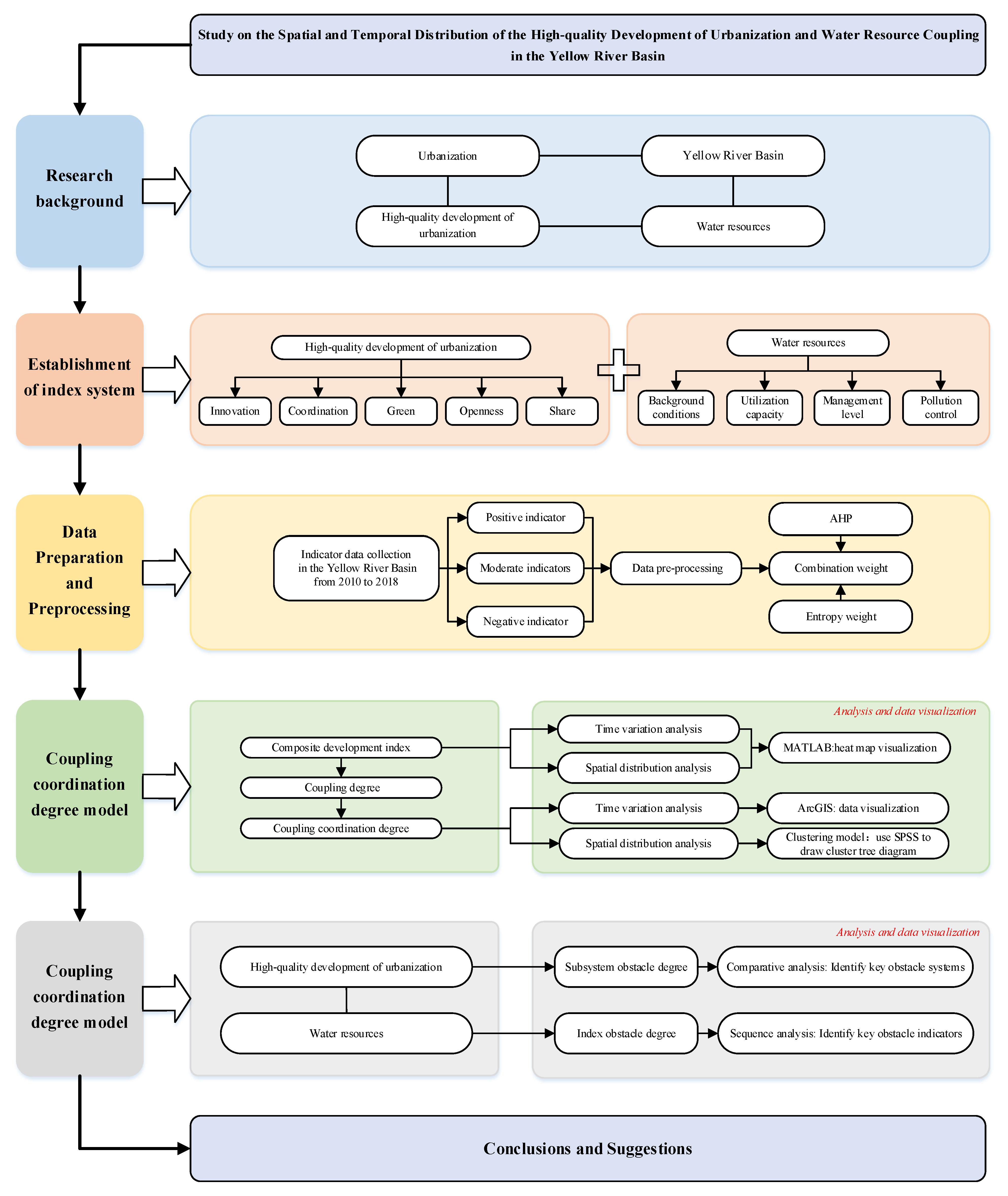
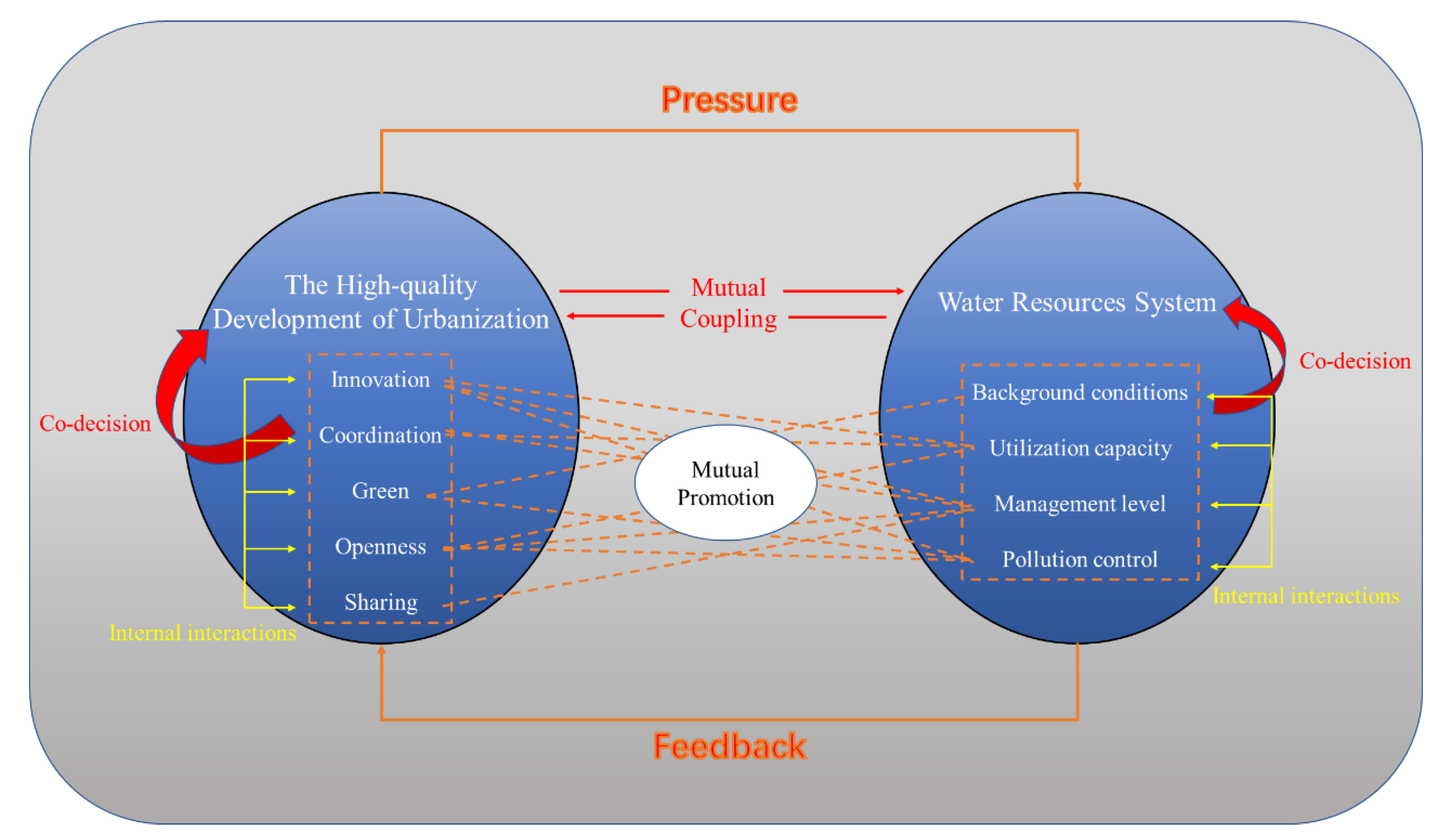
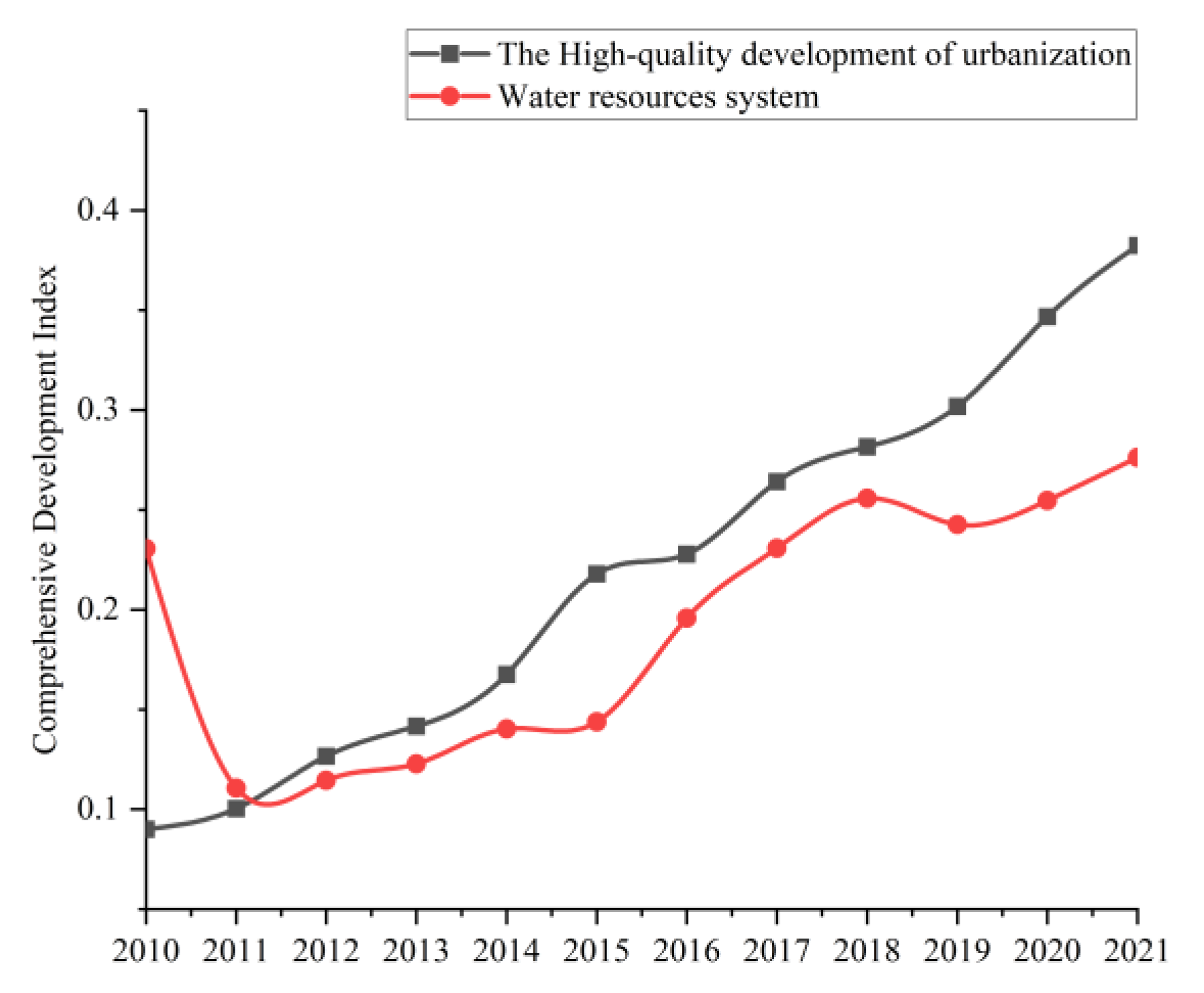

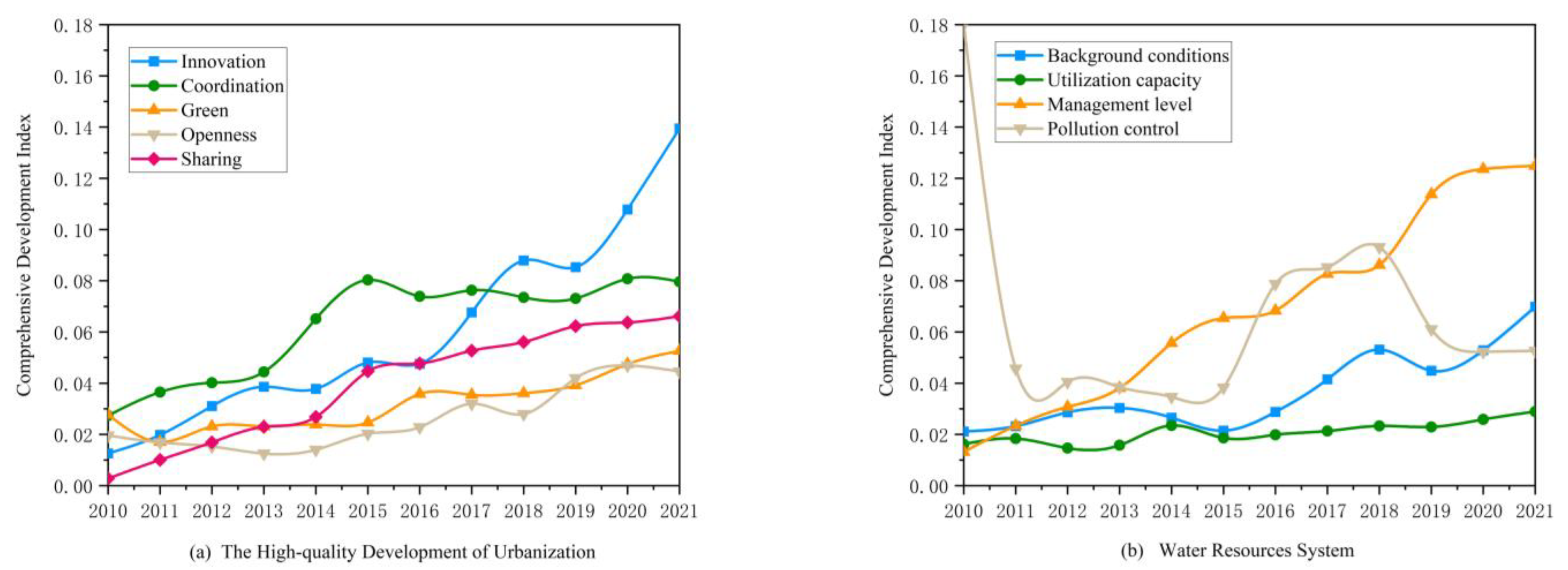
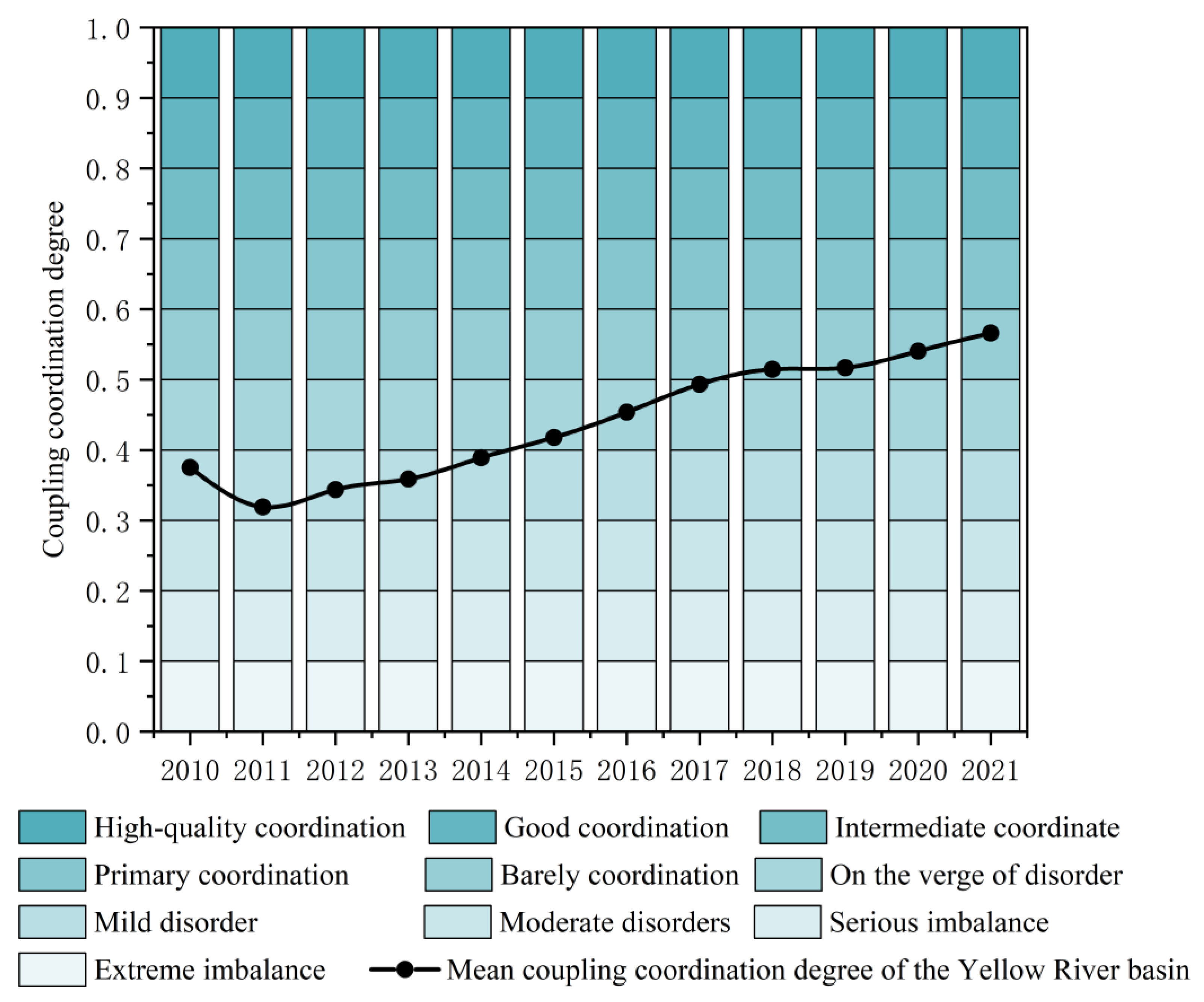
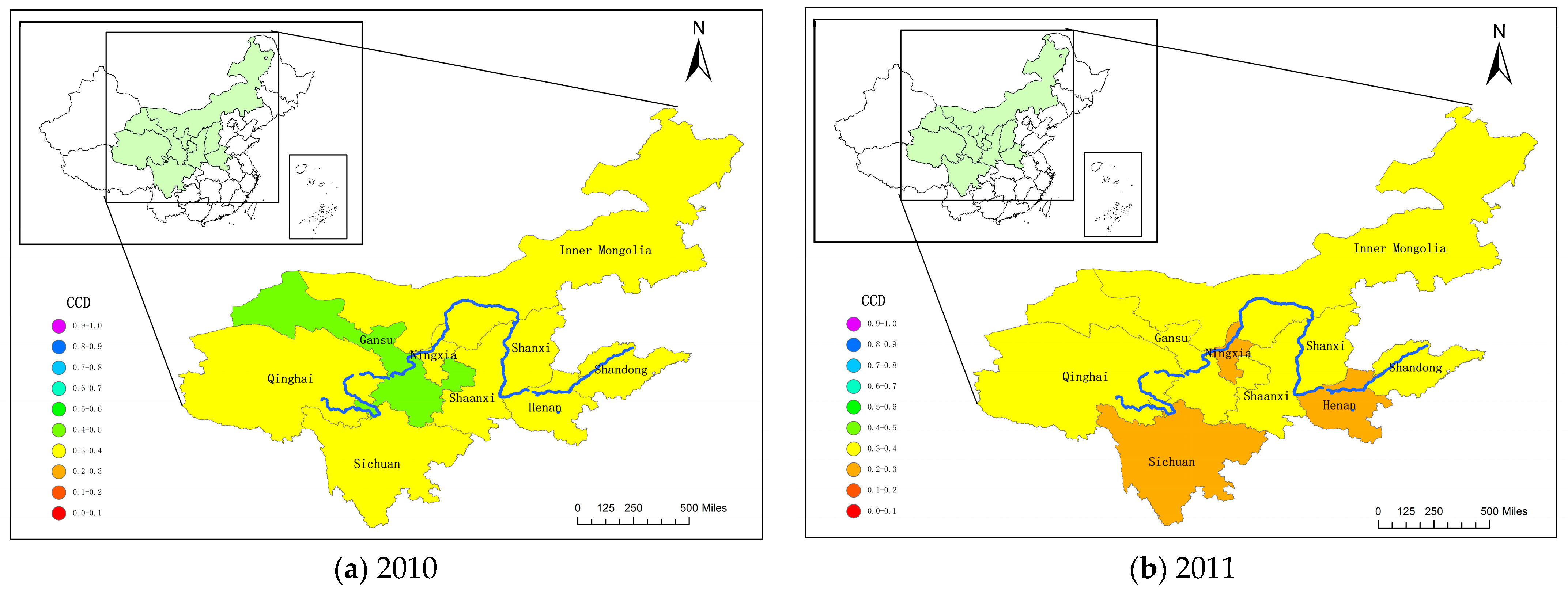
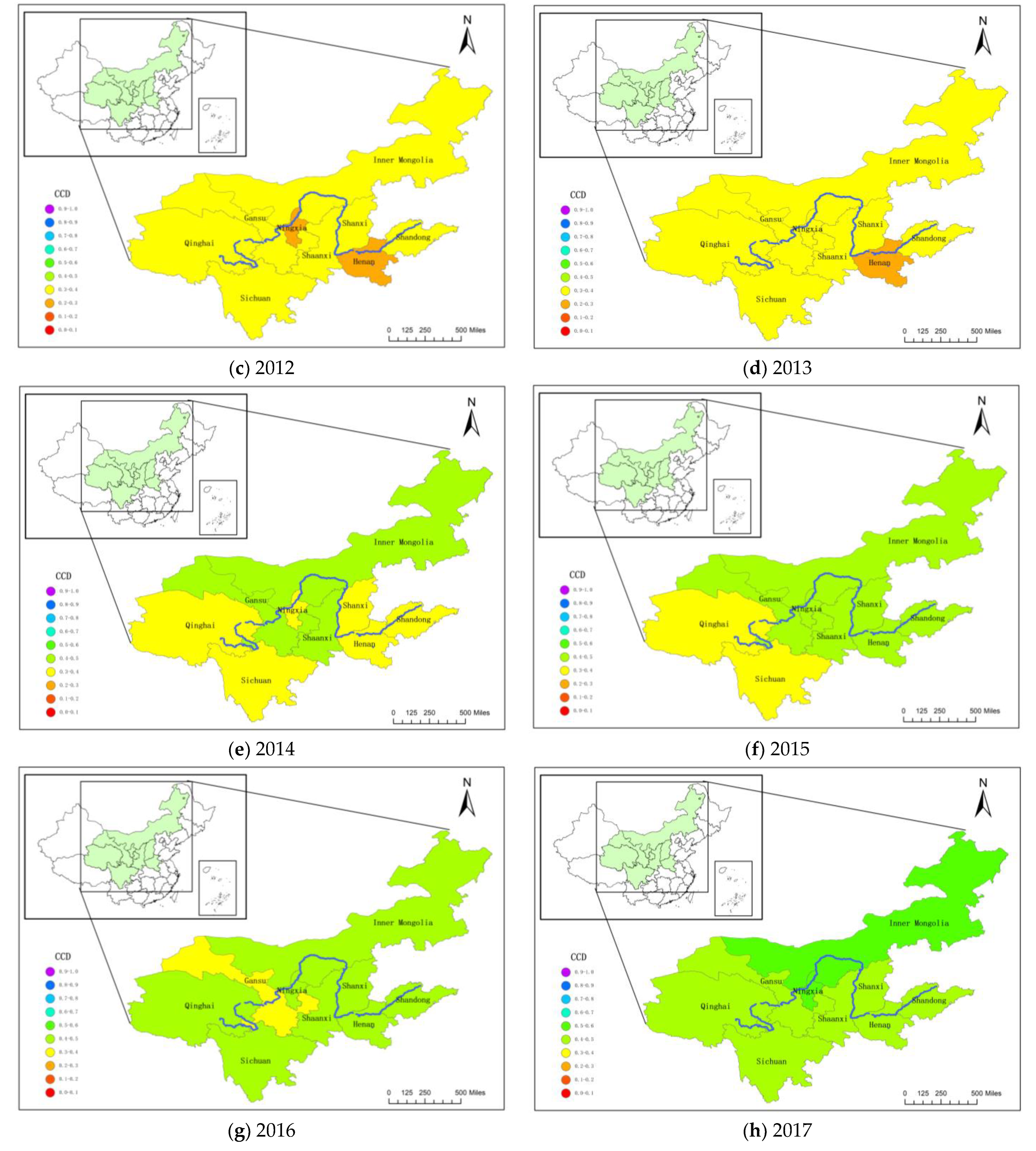
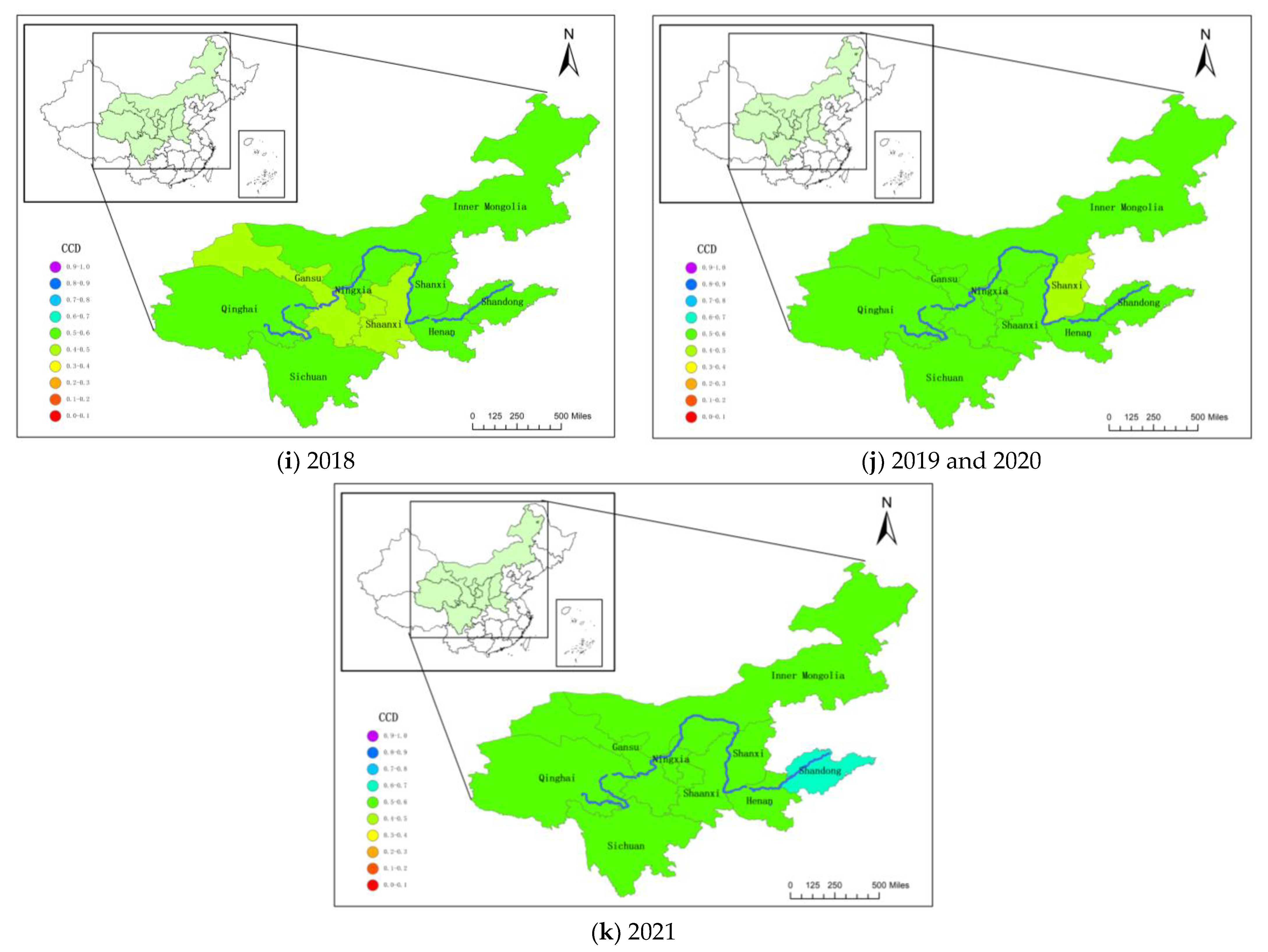
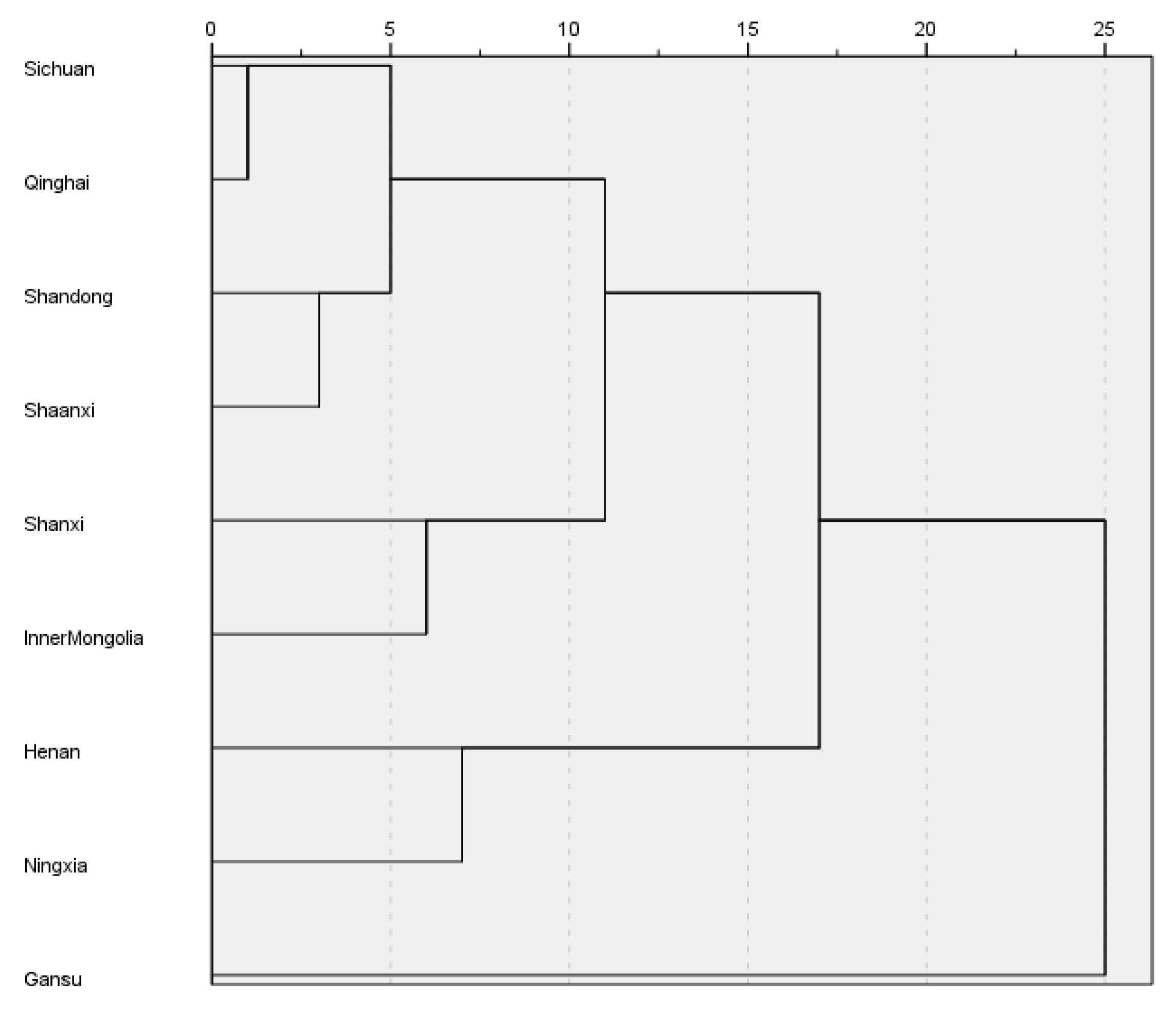
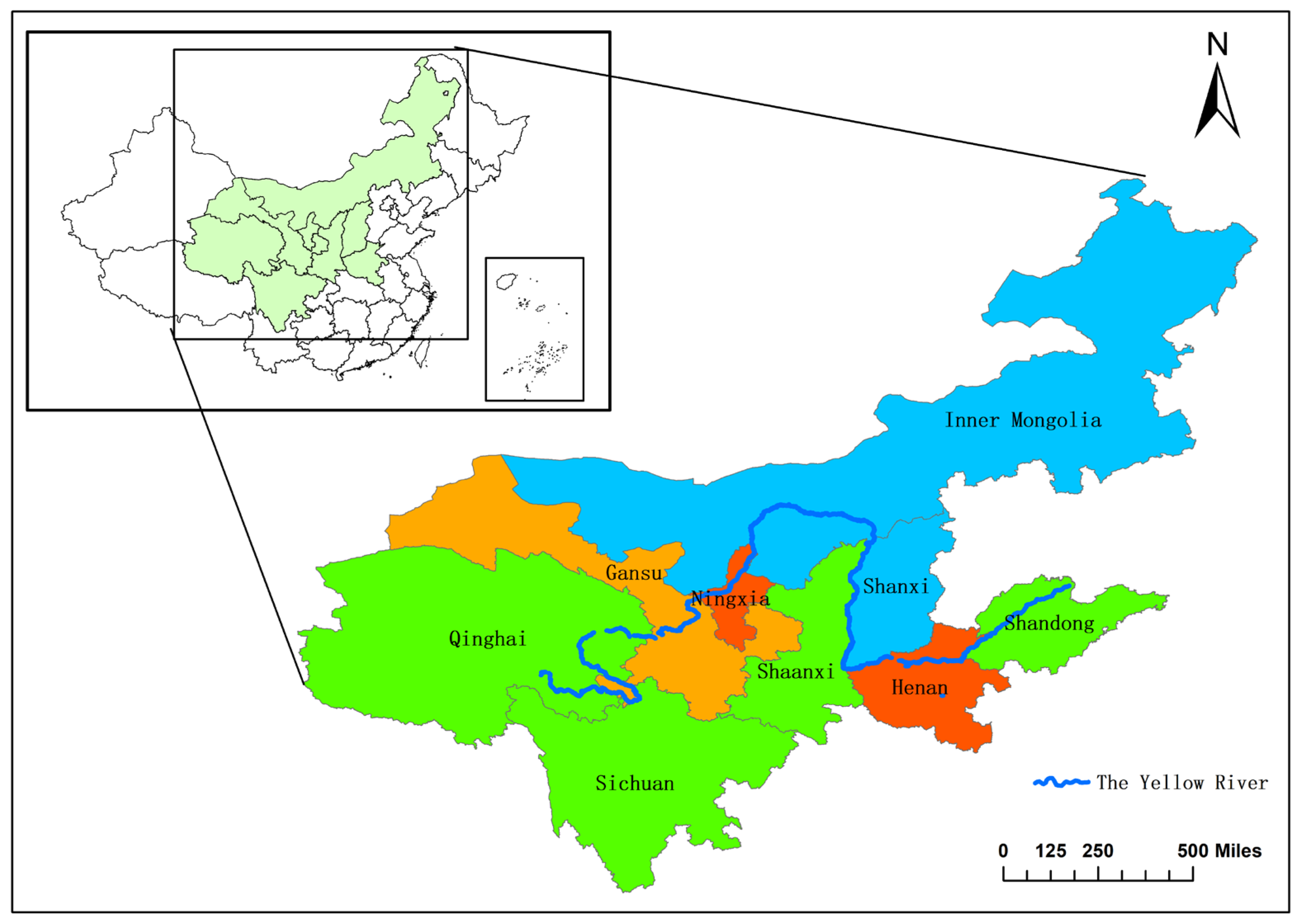
| Subsystem | Indicator | Symbols | Units | Attributes | Meaning | Origin |
|---|---|---|---|---|---|---|
| Innovation | R&D investment intensity | % | Positive | R&D expenditure/total GDP | [21] | |
| Per capita investment in science and technology | Yuan | Positive | The average expenditure of each person in the regional general public budget expenditure in science and technology | [22] | ||
| Per capita education investment | Yuan | Positive | The average expenditure of each person in the regional general public budget expenditure on education | [22] | ||
| Technology market turnover as a percentage of GDP | % | Positive | Technology market turnover/total GDP | [23] | ||
| Innovative product profitability | % | Positive | Innovative product sales revenue/industrial enterprise main business revenue | [1] | ||
| Number of students in higher education per 100,000 people | Person | Positive | Number of students in higher education × 100,000/total population | [1] | ||
| Number of patent applications granted per 10,000 people | Piece | Positive | Number of patents granted × 10,000/total population | [21] | ||
| Coordination | IU ratio | None | Moderate | Labor industrialization rate/urbanization Rate | [1] | |
| NU ratio | None | Moderate | Labor non–agriculturalization rate/urbanization rate | [1] | ||
| Coordination Index of Urbanization Economic Growth Speed | None | Positive | The average annual growth rate of urbanization rate/Average annual growth rate of per capita GDP | [24] | ||
| The proportion of tertiary industry in the GDP | % | Positive | Tertiary industry output value/total GDP | [25] | ||
| Total dependency ratio | % | Negative | Non–working–age population/working–age population in the total population | [26] | ||
| Urban–rural income level ratio | % | Negative | Disposable income per capita in urban areas/disposable income per capita in rural areas | [23] | ||
| Urban–rural consumption level ratio | % | Negative | Urban per capita consumption expenditure/rural per capita consumption expenditure | [23] | ||
| Urbanization rate | % | Positive | Urban population/total population | [27] | ||
| Green | Per capita emissions of main pollutants in the exhaust gas (sulfur dioxide + nitrogen oxides + smoke (dust)) | t/person | Negative | Main pollutants (sulfur dioxide, nitrogen oxides, and smoke (dust) emissions) in exhaust gas/total population | [21] | |
| Harmless treatment rate of domestic garbage | % | Positive | The amount of domestic garbage treated in a harmless manner/the amount of domestic garbage generated | [28] | ||
| Urban domestic sewage treatment rate | % | Positive | Urban domestic sewage treatment volume/Urban domestic sewage generation volume | [29] | ||
| The comp utilization rate of general industrial solid waste | % | Positive | The amount of solid waste extracted from general industrial solid waste or converted into usable resources, energy apprehensive other raw materials/amount of general industrial solid waste generated | [20] | ||
| Green coverage rate in the built–up area | % | Positive | The coverage area of urban built–up area/area of urban built–up area | [29] | ||
| Openness | Foreign investment openness | % | Positive | Total foreign investment/total GDP | [30] | |
| Foreign trade dependence | % | Positive | Total import and export/total GDP | [31] | ||
| Actual utilization of foreign capital as a proportion of GDP | % | Positive | Total actual utilization of foreign capital/total GDP | [32] | ||
| Sharing | Number of health technicians per thousand people | Person | Positive | Number of health technicians × 1000/total population | [33] | |
| Number of public transport vehicles per 10,000 people | Vehicles | Positive | Number of public transportation vehicles × 10,000/total population | [34] | ||
| Per capita possession of public library collections | Book/person | Positive | Public library collections/total population | [9] | ||
| Urban basic pension insurance participation rate | % | Positive | Number of people participating in urban basic endowment insurance/total population | [35] | ||
| Urban registered unemployment rate | % | Negative | Urban registered unemployed persons/(Urban employed persons + urban registered unemployed persons) | [36] | ||
| GDP per capita | Yuan/person | Positive | Total GDP/total population | [34] |
| Subsystem | Indicator | Symbols | Units | Attributes | Meaning | Origin |
| Background conditions of water resources | Total water resources | 108 m3 | Positive | The amount of surface and underground water produced by precipitation | [11] | |
| Water resources per capita | m3/person | Positive | In a region, the average amount of water resources possessed by each person in a certain period | [37] | ||
| Total urban water supply | 108 t | Positive | The total amount of water supplied by the water supply unit | [38] | ||
| Water resource utilization capacity | Water consumption per capita | m3/person | Negative | The average amount of water resources possessed by each person in a region in a certain period | [39] | |
| Water consumption per 10,000–yuan GDP | m3/104 yuan | Negative | Total water consumption/GDP | [37] | ||
| Water consumption per unit of industrial–added value | m3/ 104 yuan | Positive | Annual water consumption/industrial added value | [11] | ||
| Water resources management level | Comprehensive production capacity of water supply | 104 m3/day | Positive | Comprehensive production capacity is calculated based on the design capacity of water supply facilities such as water intake, purification, water delivery, and the ex–factory water transmission trunk pipes | [40] | |
| Urban drainage pipe length | 104 km | Positive | Refers to the sum of the lengths of all main drainage pipes, trunk pipes, branch pipes, inspection wells, connecting well inlets and outlets, etc. | [41] | ||
| City water supply pipeline length | km | Positive | Refers to the length of all pipes from the water pump to the user’s water meter | [42] | ||
| Water pollution control | Total wastewater discharge | 104 t | Negative | Wastewater discharge refers to the amount of water discharged by water users such as industry, tertiary industry, urban residents, etc. | [14] | |
| Cod | 104 t | Negative | Under acidic conditions, the amount of oxygen consumed to oxidize organic matter to CO2 and H2O with a strong oxidant | [14] | ||
| The daily treatment capacity of urban sewage | 104 m3 | Positive | Refers to the design capacity of the sewage treatment plant to treat sewage per day and night | [42] |
| 1 | 2 | 3 | 4 | 5 | 6 | 7 | 8 | 9 | 10 | 11 | |
| 0 | 0 | 0.58 | 0.90 | 1.12 | 1.24 | 1.32 | 1.41 | 1.46 | 1.49 | 1.52 |
| Coupling Degree | Coupling Type | Feature |
|---|---|---|
| 0–0.29 | Low coupling stage | The two subsystems start to play a game, and the coupling degree is at a low level. |
| 0.3–0.49 | Antagonistic stage | The interaction between the two subsystems is strengthened, the dominant subsystem begins to occupy the space of the other subsystems, and the other subsystem continues to decline continually. |
| 0.5–0.79 | Run–in stage | The two subsystems balance and cooperate with each other, showing benign coupling characteristics. |
| 0.8–1 | Coordinated coupling stage | The two subsystems become more coupled and gradually develop toward an orderly direction, and are in a period of high–level coupling coordination. |
| Type | D | Grade | The Relationship between S1 and S2 | Specific Description |
|---|---|---|---|---|
| Disorder recession | 0–0.09 | Extreme imbalance | S1 > S2 | Backward WRS type |
| S1 < S2 | Backward HQDU type | |||
| S1 = S2 | Synchronization of HQDU and WRS type | |||
| 0.1–0.19 | Serious imbalance | S1 > S2 | Backward WRS type | |
| S1 < S2 | Backward HQDU type | |||
| S1 = S2 | Synchronization of HQDU and WRS type | |||
| 0.2–0.29 | Moderate Disorder | S1 > S2 | Backward WRS type | |
| S1 < S2 | Backward HQDU type | |||
| S1 = S2 | Synchronization of HQDU and WRS type | |||
| Transition class | 0.3–0.39 | Mild disorder | S1 > S2 | Backward WRS type |
| S1 < S2 | Backward HQDU type | |||
| S1 = S2 | Synchronization of HQDU and WRS type | |||
| 0.4–0.49 | On the verge of disorder | S1 > S2 | Backward WRS type | |
| S1 < S2 | Backward HQDU type | |||
| S1 = S2 | Synchronization of HQDU and WRS type | |||
| 0.5–0.59 | Barely coordination | S1 > S2 | Backward WRS type | |
| S1 < S2 | Backward HQDU type | |||
| S1 = S2 | Synchronization of HQDU and WRS type | |||
| 0.6–0.69 | Primary coordination | S1 > S2 | Backward WRS type | |
| S1 < S2 | Backward HQDU type | |||
| S1 = S2 | Synchronization of HQDU and WRS type | |||
| Coordinated development category | 0.7–0.79 | Intermediate coordinate | S1 > S2 | Backward WRS type |
| S1 < S2 | Backward HQDU type | |||
| S1 = S2 | Synchronization of HQDU and WRS type | |||
| 0.8–0.89 | Good coordination | S1 > S2 | Backward WRS type | |
| S1 < S2 | Backward HQDU type | |||
| S1 = S2 | Synchronization of HQDU and WRS type | |||
| 0.9–1 | High–quality coordination | S1 > S2 | Backward WRS type | |
| S1 < S2 | Backward HQDU type | |||
| S1 = S2 | Synchronization of HQDU and WRS type |
| System | High–Quality Development of Urbanization System | Water Resources System | |||||||
|---|---|---|---|---|---|---|---|---|---|
| Subsystem | Innovation | Coordination | Green | Openness | Share | Background Conditions | Utilization Capacity | Management Level | Pollution Control |
| 2010 | 35.56% | 25.70% | 9.25% | 11.20% | 18.30% | 28.56% | 8.86% | 49.14% | 13.44% |
| 2011 | 34.71% | 24.02% | 12.03% | 12.29% | 16.95% | 18.89% | 5.34% | 31.81% | 43.96% |
| 2012 | 33.97% | 24.87% | 11.28% | 13.56% | 16.32% | 17.70% | 6.41% | 30.14% | 45.75% |
| 2013 | 33.34% | 24.67% | 11.70% | 14.94% | 15.35% | 17.42% | 6.16% | 28.74% | 47.67% |
| 2014 | 36.16% | 20.28% | 12.52% | 15.64% | 15.40% | 19.62% | 4.40% | 24.79% | 51.19% |
| 2015 | 39.32% | 18.55% | 14.40% | 16.17% | 11.56% | 21.24% | 5.75% | 22.51% | 50.49% |
| 2016 | 40.79% | 21.49% | 10.94% | 15.66% | 11.13% | 22.34% | 6.52% | 24.83% | 46.31% |
| 2017 | 38.61% | 23.94% | 12.60% | 14.02% | 10.83% | 21.04% | 6.46% | 23.22% | 49.29% |
| 2018 | 32.09% | 27.21% | 13.40% | 17.17% | 10.13% | 18.49% | 6.41% | 24.47% | 50.62% |
| 2019 | 36.69% | 30.39% | 13.29% | 11.90% | 7.72% | 20.98% | 6.41% | 12.91% | 59.70% |
| 2020 | 32.36% | 34.30% | 11.48% | 12.55% | 9.31% | 18.30% | 5.12% | 8.81% | 67.77% |
| 2021 | 13.17% | 47.52% | 10.90% | 17.88% | 10.53% | 12.53% | 4.08% | 8.29% | 75.10% |
| The HQDU | The WRS | |||||||||
|---|---|---|---|---|---|---|---|---|---|---|
| Ranking | 1 | 2 | 3 | 4 | 5 | 1 | 2 | 3 | 4 | 5 |
| 2010 | A4 | A10 | A21 | A5 | A7 | B7 | B3 | B8 | B12 | B9 |
| 2011 | A4 | A10 | A21 | A5 | A7 | B10 | B7 | B11 | B3 | B8 |
| 2012 | A21 | A10 | A4 | A5 | A7 | B10 | B7 | B11 | B3 | B8 |
| 2013 | A21 | A4 | A10 | A5 | A7 | B10 | B7 | B11 | B3 | B4 |
| 2014 | A21 | A4 | A5 | A10 | A7 | B10 | B7 | B11 | B3 | B2 |
| 2015 | A4 | A21 | A5 | A7 | A16 | B10 | B7 | B11 | B3 | B2 |
| 2016 | A5 | A4 | A21 | A10 | A7 | B10 | B7 | B3 | B2 | B1 |
| 2017 | A10 | A4 | A7 | A5 | A21 | B10 | B7 | B3 | B2 | B1 |
| 2018 | A10 | A21 | A7 | A4 | A5 | B10 | B7 | B3 | B4 | B2 |
| 2019 | A10 | A4 | A7 | A19 | A5 | B10 | B11 | B7 | B3 | B2 |
| 2020 | A10 | A4 | A19 | A7 | A23 | B10 | B11 | B3 | B7 | B4 |
| 2021 | A10 | A19 | A23 | A21 | A4 | B10 | B11 | B7 | B3 | B4 |
Disclaimer/Publisher’s Note: The statements, opinions and data contained in all publications are solely those of the individual author(s) and contributor(s) and not of MDPI and/or the editor(s). MDPI and/or the editor(s) disclaim responsibility for any injury to people or property resulting from any ideas, methods, instructions or products referred to in the content. |
© 2023 by the authors. Licensee MDPI, Basel, Switzerland. This article is an open access article distributed under the terms and conditions of the Creative Commons Attribution (CC BY) license (https://creativecommons.org/licenses/by/4.0/).
Share and Cite
Huang, X.; Shen, J.; Sun, F.; Wang, L.; Zhang, P.; Wan, Y. Study on the Spatial and Temporal Distribution of the High–Quality Development of Urbanization and Water Resource Coupling in the Yellow River Basin. Sustainability 2023, 15, 12270. https://doi.org/10.3390/su151612270
Huang X, Shen J, Sun F, Wang L, Zhang P, Wan Y. Study on the Spatial and Temporal Distribution of the High–Quality Development of Urbanization and Water Resource Coupling in the Yellow River Basin. Sustainability. 2023; 15(16):12270. https://doi.org/10.3390/su151612270
Chicago/Turabian StyleHuang, Xin, Juqin Shen, Fuhua Sun, Lunyan Wang, Pengchao Zhang, and Yu Wan. 2023. "Study on the Spatial and Temporal Distribution of the High–Quality Development of Urbanization and Water Resource Coupling in the Yellow River Basin" Sustainability 15, no. 16: 12270. https://doi.org/10.3390/su151612270
APA StyleHuang, X., Shen, J., Sun, F., Wang, L., Zhang, P., & Wan, Y. (2023). Study on the Spatial and Temporal Distribution of the High–Quality Development of Urbanization and Water Resource Coupling in the Yellow River Basin. Sustainability, 15(16), 12270. https://doi.org/10.3390/su151612270






